How to Create Your First Paid Social Media Campaign (Step-by-Step)
Struggling to reach a wider audience organically? Not seeing the traction your content deserves, even after consistent posting? If you’re looking for faster, more targeted results, it might be time to launch your first paid social media campaign.
According to Statista, global social media ad spending is expected to reach over $234.14 billion in 2024. It highlights how brands are increasingly prioritizing paid strategies to cut through the noise and drive results.
A paid social media campaign is a form of digital advertising where brands promote content through paid placements on social media platforms. Unlike organic posts, which rely on algorithms and follower engagement, paid campaigns allow you to reach specific audiences at scale, with precision and control. In today’s competitive digital landscape, they’re not just optional—they’re essential.
Why does it matter? A well-planned paid social media campaign can boost visibility beyond your existing followers, engage high-intent users, and deliver faster ROI. It offers a clear edge over businesses still relying solely on organic growth.
In this blog, you’ll discover a step-by-step guide to setting up your first campaign—from setting goals and choosing platforms to creating compelling ads and analyzing performance. Let’s get started.
What is a paid social media campaign?
A paid social media campaign is a marketing strategy where businesses promote their content through paid advertisements on platforms like Facebook, Instagram, LinkedIn, and X. Unlike regular (organic) posts that only reach your existing followers or people who stumble upon your content, paid campaigns allow you to target specific audiences.
So, what’s the real difference between paid vs. organic social media? Organic content helps build brand presence over time without spending money, but its reach is limited, especially with constantly changing algorithms. Paid campaigns, on the other hand, give you control over who sees your message and when. They’re ideal if you want to boost visibility, drive traffic, or generate leads quickly.
Some of the most effective paid social media campaigns combine creative storytelling with targeted messaging, delivering the right message to the right people at the right time.
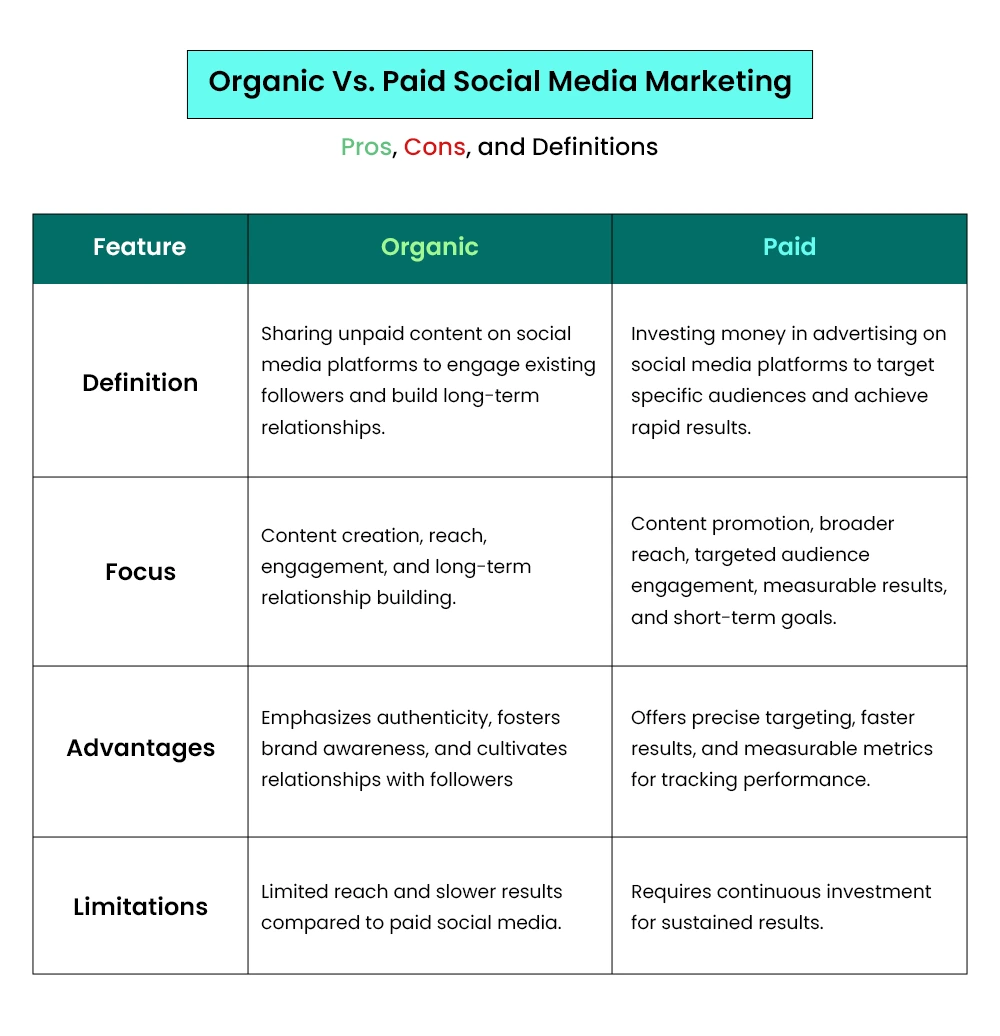
Why Invest in a Paid Social Media Campaign?
If you’re wondering whether it’s worth putting money behind your posts, the short answer is: absolutely. Social media paid campaigns offer advantages that organic efforts simply can’t match, especially when you’re just starting and need results quickly.
Here’s why investing in a paid social media campaign is a smart move:
- Targeted Audience Reach: You can pinpoint exactly who sees your ad by age, interests, behavior, location, and more. No more crossing your fingers, hoping the right people find your content.
- Faster Results: Unlike organic posts, which can take weeks or months to gain traction, paid campaigns deliver immediate visibility and engagement.
- Control Over Budget & Performance: You set the budget, you control the pace. Pause, adjust, or scale as needed—it’s all in your hands.
- Data-Driven Optimization: With access to performance metrics, you can see what’s working and what’s not, then tweak your campaign for better results.
- Stronger ROI & Scalability: Start small, measure success, and scale up when you’re ready. Many of the most successful brands rely heavily on social media paid campaigns for consistent growth.
Bottom line? If you’re serious about reaching the right audience and growing your brand faster, paid social is the way to go.
– Also Read- What is Paid Media: Types, Benefits, Best Practices and Examples
Pre-Campaign Essentials: Laying the Foundation
Before moving forward, here are some pre-campaign essentials that will lay the social media campaign foundation:
1. Define Your Campaign Goals
Before launching any ads, you need to be crystal clear about why you’re running them. Setting SMART (Specific, Measurable, Achievable, Relevant, Time-bound) goals is the first step in creating effective social media paid campaigns.
Your campaign goal will shape everything—from your creative to your targeting to how you measure success. Here are a few common objectives:
- Awareness: Want more people to know about your brand? Focus on reach and impressions.
- Engagement: Looking to spark conversations or build a community? Track likes, comments, and shares.
- Lead Generation: Driving traffic to your website or collecting sign-ups? Look at clicks and form submissions.
- Sales/Conversions: Want people to buy or subscribe? Focus on conversions and return on ad spend (ROAS).
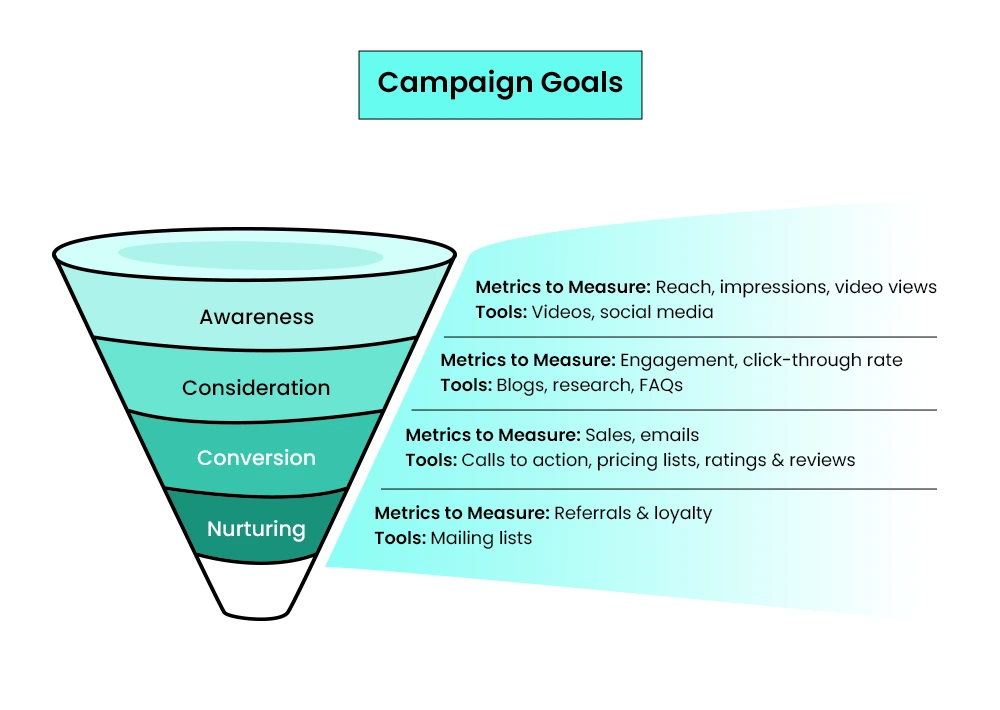
Clearly defined goals are the foundation of any successful paid social media campaign—they help guide every decision and maximize your results.
2. Understand Your Target Audience
Before spending a single dollar, you need to know who you’re trying to reach. One of the biggest mistakes in paid campaigns on social media is targeting too broadly. The more specific you are, the more effective your ads will be—and the better your campaign budget optimization.
Start by breaking down your ideal audience:
- Demographics: Age, location, gender, income level
- Psychographics: Interests, behaviors, lifestyle, and values
- Pain Points & Needs: What problems are they trying to solve? What do they care about?
Take the time to create detailed buyer personas. These are fictional profiles that represent your ideal customers. They’ll help you craft messages that resonate and choose the right platform for your paid social media campaign. The better you understand your audience, the more efficiently your ad dollars will work for you.
3. Set Your Budget (and Understand Bidding Strategies)
Your budget plays a big role in how far your paid social media campaign will go. Thankfully, you don’t need a huge spend to get started, but you do need a plan.
First, choose between a daily budget (how much you’re willing to spend per day) or a lifetime budget (total spend over the campaign’s duration). Both offer flexibility depending on your goals and timeline.
Next, understand basic bidding strategies:
- Lowest Cost: Let the platform get the most results for your budget.
- Bid Cap: You set the maximum bid you’re willing to pay per result.
- Cost Cap: Aims to keep your average cost per result within a target range.
Start small, monitor results, and scale as you learn what works. Smart budgeting and bidding help you avoid overspending while maximizing results, which is key to creating an effective paid social media campaign that delivers.
4. Choose Your Social Media Platforms Wisely
Not every platform is right for every brand. When planning your first paid social campaign, it’s crucial to pick platforms where your target audience spends time.
For example:
- Facebook & Instagram are great for broad reach and visual storytelling.
- LinkedIn works best for B2B or professional services.
- TikTok is ideal for younger, video-loving audiences.
- X (formerly Twitter) suits real-time updates and conversations.
- Pinterest is strong for lifestyle, fashion, and DIY niches.
Each platform also offers unique ad formats—like Instagram Stories, TikTok In-Feed ads, or LinkedIn Sponsored Content—so your creative needs may vary.
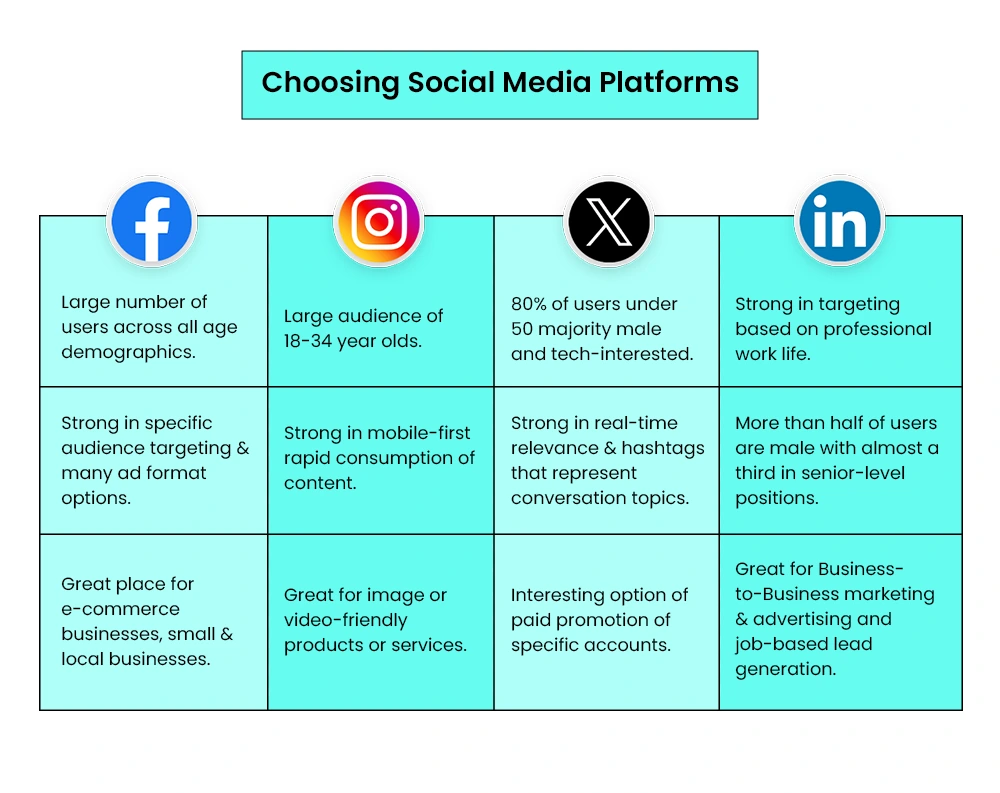
Consider your goals and target audience when selecting where to run your paid social campaign. The right channel can make all the difference in performance, reach, and ROI. Different platforms serve different social campaigns, so choose strategically, not just based on popularity.
– Also Read- How to Boost Organic Social Media Growth for Ecommerce Business?
Step-by-Step Guide: Launching Your First Paid Social Media Campaign
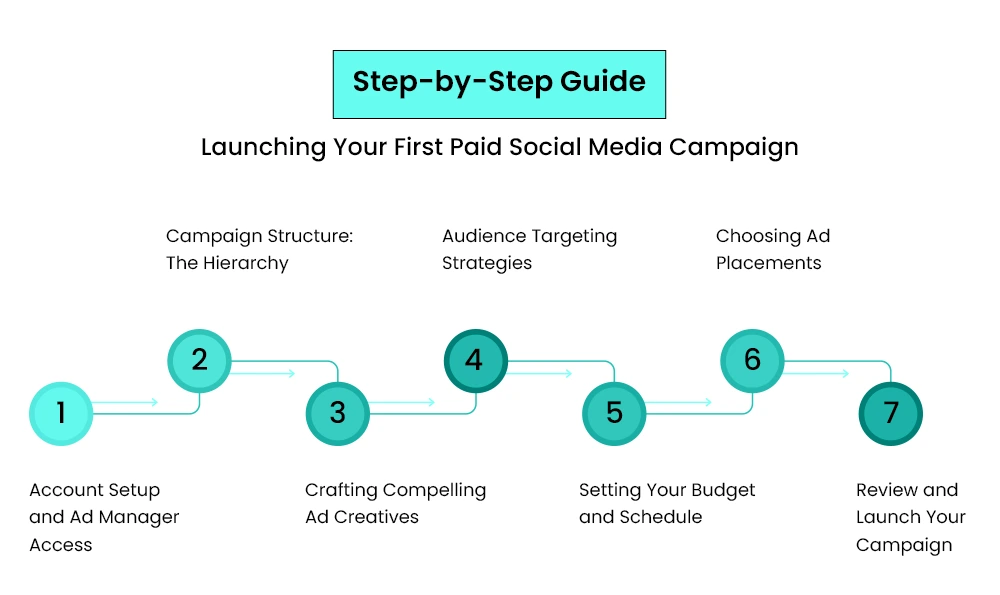
When it comes to how to set up a paid social media campaign, here are some steps you need to follow:
1. Account Setup and Ad Manager Access
Before you can launch your first social ad campaign, you need to set up the tools that power your ads. The process is fairly simple, but getting it right from the start sets the foundation for smooth execution and better results.
If you’re using platforms like Facebook or Instagram, begin by creating a Meta Business Manager account. This is where you’ll manage your pages, ad accounts, and team access, all in one place. Once that’s done, go ahead and set up your Ad Account within Business Manager. This is where you’ll run and monitor all your campaigns.
Don’t forget to link your payment method. You can choose from credit/debit cards, PayPal, or direct debit. Just make sure it’s secure and active so there are no billing issues once your ads go live.
This step is essential for anyone serious about getting started with paid social advertising. Think of it as setting up your command center. Once it’s ready, you’ll be equipped to launch, monitor, and scale your first paid social media campaign like a pro.
2. Campaign Structure: The Hierarchy
To run a successful paid social media campaign, you need to understand how campaigns are structured. Most platforms like Meta (Facebook/Instagram), LinkedIn, and TikTok follow a similar three-level hierarchy. Knowing how each layer works helps you manage your ad campaigns more effectively.
Here’s a quick breakdown:
- Campaign: This is the top level where you define your main objective, such as brand awareness, traffic, engagement, lead generation, or conversions. Your goal here drives everything that follows.
- Ad Set: Within each campaign, you can create one or more ad sets. This is where you define your audience targeting (age, interests, location, etc.), set your budget and schedule, and choose where your ads will appear (placements). It’s the strategic heart of your campaign.
- Ad: This is the final layer, your actual content. Here, you select your creative (images, videos, carousels), write your copy, and set your call to action. Different ad types give you flexibility in how you deliver your message.
Understanding this structure allows you to test and tweak each layer for better performance. It’s one of the key steps in building well-organized and results-driven ad campaigns that work.
3. Crafting Compelling Ad Creatives
Your creativity is what grabs attention, so make it count. Whether you’re using images, videos, or carousels, high-performing paid social ads start with strong, scroll-stopping visuals and clear messaging.
Here’s how to get it right:
- Image/Video Best Practices: Use high-quality visuals that are relevant to your offer and resonate with your audience. For videos, keep them short, engaging, and optimized for mobile.
- Ad Copywriting Tips: Your copy should be clear, concise, and focused on benefits. Address a pain point or desire, and explain how your product or service solves it.
- Strong CTA (Call to Action): Always tell people what to do next—whether it’s “Shop Now,” “Learn More,” or “Sign Up.” A strong CTA boosts engagement and conversions.
Good Example: A clear image of your product, a headline like “Struggling to Sleep? Try Our All-Natural Sleep Aid,” and a “Buy Now” button.
Bad Example: A blurry image, vague copy like “Check this out,” and no clear next step.
Different ad formats offer creative flexibility, but the formula stays the same: strong visual + sharp message + clear CTA = results. Your creativity is the face of your paid social media campaign, so make it work hard for you.
4. Audience Targeting Strategies
Paid social media advertising provides the ability to reach a targeted audience of people who are most likely to engage with your brand or buy your product. Smart targeting can make or break your paid social media campaign.
Here are three key types of audience targeting:
- Core Audiences: These are built from basic details like age, gender, location, interests, and behaviors. It’s great for reaching people who might be interested based on general traits.
- Custom Audiences: You can target users who’ve already interacted with your brand, like website visitors, app users, or email subscribers. These are warm leads who already know you.
- Lookalike Audiences: These are new users who share traits with your existing customers. Platforms like Facebook and LinkedIn can help you reach people similar to your best buyers.
The power of targeting lies in delivering the right message to the right people. Instead of wasting budget on broad reach, you focus only on those who matter—boosting engagement, lowering costs, and improving ROI. If you’re serious about results, mastering your targeted audience strategy is essential for running successful paid campaigns.
5. Setting Your Budget and Schedule
Now that your creatives and ads target are ready, it’s time to decide how much you want to spend and when your ads should run. Budgeting and scheduling are key parts of any paid social media advertising strategy, as they control how long your campaign runs and how far it reaches.
Here’s what to consider:
- Daily vs. Lifetime Budget: A daily budget controls how much you spend per day, giving you steady exposure. A lifetime budget sets a total amount for the entire campaign and allows the platform to optimize delivery across that period.
- Start and End Dates: Choose when your campaign should go live and when it should stop. This is especially useful for promotions or time-sensitive offers.
- Ad Scheduling (Dayparting): If your audience is more active at certain times of the day, you can schedule your ads to show only during those peak hours for better performance and cost-efficiency.
Your budget doesn’t have to be massive. Start small, monitor results, and scale up once you see what’s working. This step ensures you stay in control of your spending while staying aligned with your paid social media advertising strategy goals.
6. Choosing Ad Placements
Your budget doesn’t have to be massive. Start small, monitor results, and scale up once you see what’s working. This step ensures you stay in control of your spending while staying aligned with your paid social media advertising strategy goals.
When it comes to paid social media marketing, where your ads appear is just as important as the ad itself. Choosing the right ad placements ensures your message reaches your audience in the most impactful way.
You’ll usually be given two options:
- Automatic Placements: This is where the platform (like Meta or LinkedIn) decides where your ad will show—whether that’s in the Feed, Stories, Reels, or even the Audience Network. It’s great for beginners or when you’re not sure where your audience hangs out, as it helps you get the most results for your budget.
- Manual Placements: If you have a more refined strategy, manual placements let you choose exactly where your ad appears. For example, you may only want to run Story ads on Instagram or skip Audience Network placements altogether.
Understanding your audience’s behavior helps here. Are they likely to tap through Stories or scroll through Feeds? Your answers will shape your digital marketing success.
The goal is to place your ads where they’ll be seen, engaged with, and acted on. So, whether you go automatic or manual, make sure your placements align with your campaign goals and audience behavior. Smart placements make your paid social media marketing dollars work harder.
7. Review and Launch Your Campaign
You’re almost there! Before you hit that “Publish” button, take a moment to review every element of your paid social media campaign thoroughly. This final step might seem simple, but it’s where small mistakes can make a big impact.
Here’s what to do before launching:
- Double-check all your settings- Make sure your targeting, budget, schedule, and placements align with your campaign goals.
- Preview your ads- Look at how they appear across different devices and placements. Ensure your images/videos are high-quality and your copy is clear, engaging, and aligned with what your audience needs.
- Hit “Launch” or “Publish”- Once everything checks out, go ahead and set your campaign live!
Launching a campaign isn’t just about pressing a button. It’s about confidently sharing a message with people who are already interested in your product or service and making sure that message lands the right way.
This step wraps up your setup process, but it’s also the beginning of your campaign’s performance journey. Now the real data comes in, and you can optimize from here. Let the results roll in!
Common Mistakes to Avoid in Your First Paid Social Media Campaign
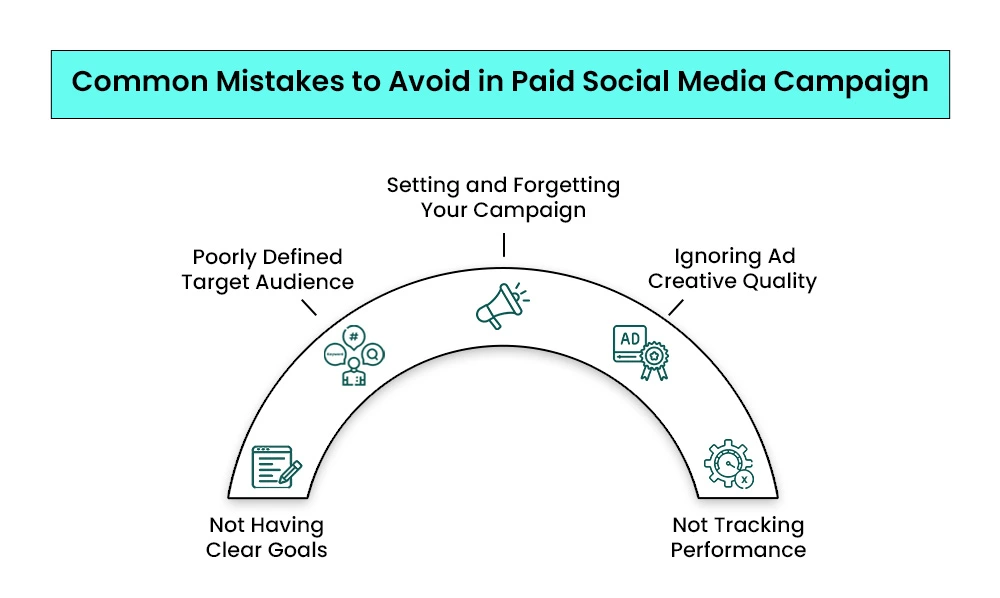
Check out some of these common social media ad mistakes that you need to avoid.
1. Not Having Clear Goals
One of the biggest mistakes beginners make with their paid social media campaign is jumping in without setting clear goals. If you don’t know what success looks like, how will you measure it? Whether you want more website visits, leads, or purchases, your campaign needs direction.
Without clear goals, you risk wasting budget, targeting the wrong specific audience, or creating ads that don’t convert. Set SMART goals from the start to guide your decisions, track performance, and make your campaign more effective from day one.
2. Poorly Defined Target Audience
Another common misstep when you run paid campaigns for the first time is not clearly defining your target audience. If you’re trying to speak to everyone, you end up connecting with no one. In paid social marketing, the power lies in precision, knowing exactly who your message is for.
Take time to understand your audience’s demographics, interests, and behaviors. A well-defined audience ensures your ads reach people who are more likely to engage and convert, making every dollar you spend work harder. Avoid the spray-and-pray approach—target smarter, not wider.
3. Ignoring Ad Creative Quality
In paid social marketing, the quality of your ad creative can make or break your campaign. Even with the right audience targeting and budget, dull visuals or unclear messaging can lead to poor performance. Your paid social ads should be visually appealing, relevant to your audience, and paired with a strong call to action.
Compelling copy and high-quality images or videos help stop the scroll and drive engagement. Don’t treat creativity as an afterthought—it’s a key driver of clicks, conversions, and overall success in any paid campaign.
4. Setting and Forgetting Your Campaign
A common beginner mistake? Launching your social ad campaign and never looking back. In reality, a successful paid social media strategy needs ongoing attention. Campaigns aren’t “set it and forget it” — they require regular check-ins to monitor performance, tweak targeting, test creatives, and adjust budgets.
Without optimization, even well-planned ads can lose steam or miss the mark entirely. Keep an eye on your metrics, experiment with small changes, and stay flexible. The best results come from refining your campaign as you learn what works—and what doesn’t.
5. Not Tracking Performance
Failing to monitor performance metrics can quickly derail your paid social media campaign. Without insights into how your ads are performing, such as click-through rates, conversions, and cost per result. It’s impossible to know where your money is going or what’s delivering real value.
Performance tracking allows you to identify which creatives resonate, which audiences convert, and where to adjust your budget. With proper tracking in place, you’re not just spending, you’re learning, optimizing, and improving your campaign’s impact every step of the way.
– Also Read- 10 Social Media Marketing Mistakes Killing Your Organic Growth
Conclusion
Creating a successful paid social media campaign starts with a solid foundation, defining clear goals, understanding your audience, setting a budget, and choosing the right platforms. From there, it’s all about building structured ad campaigns, crafting compelling creatives, targeting effectively, and continually tracking performance to optimize results.
Remember, you don’t have to get everything perfect on your first try. Paid social is a learning process. The more you test, tweak, and analyze, the better your outcomes will be over time.
Ready to launch your first paid social media campaign? Go for it and don’t hesitate to drop your questions or experiences in the comments below. We’d love to hear from you. Want more practical tips like these? Subscribe to our newsletter and get step-by-step marketing insights delivered straight to your inbox.
A well-executed paid social media campaign doesn’t just boost visibility—it builds real, scalable growth for your business. To create an effective paid social media marketing campaign, reach out to us at Mastroke!
FAQs-
1. What is a paid social media campaign?
A paid social media campaign involves promoting content through ads on platforms like Facebook, Instagram, or LinkedIn. Unlike organic posts, these ads target specific audiences and are backed by a set budget, helping you reach more users, drive engagement, generate leads, or boost conversions more effectively.
2. How much should I spend on my first campaign?
For your first campaign, start small—anywhere from $5 to $20 per day is enough to test ad creatives, targeting, and messaging. This approach allows you to learn what works before scaling up, making the most of your budget while minimizing risk.
3. Which platform is best for beginners?
Facebook (Meta) is often the best platform for beginners due to its user-friendly Ad Manager, robust targeting options, and large user base. Instagram (via Meta) is another great option if your audience is visually driven. Both platforms are ideal for testing and learning the basics of paid advertising.
4. How long should I run my first campaign?
Run your first campaign for at least 7 to 10 days. This gives platforms enough time to optimize ad delivery and provide meaningful performance data. Avoid stopping too early—ad algorithms need time to learn and identify the best audience for your campaign.
5. Can I run paid campaigns without a website?
Yes, you can run paid social media campaigns without a website by directing users to a landing page, lead form, or even your social media profile. However, having a dedicated webpage improves credibility and conversions and is highly recommended for long-term success.